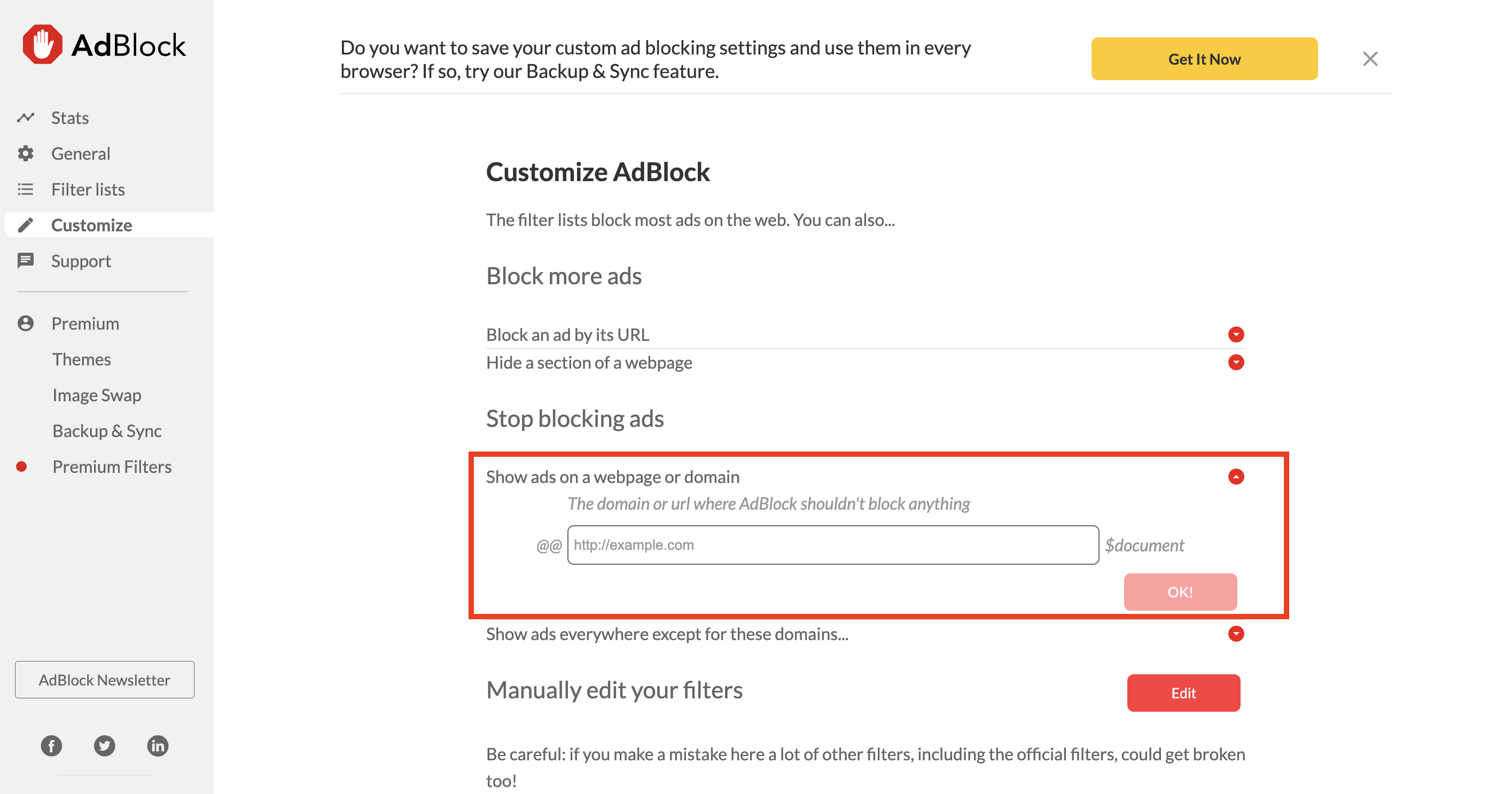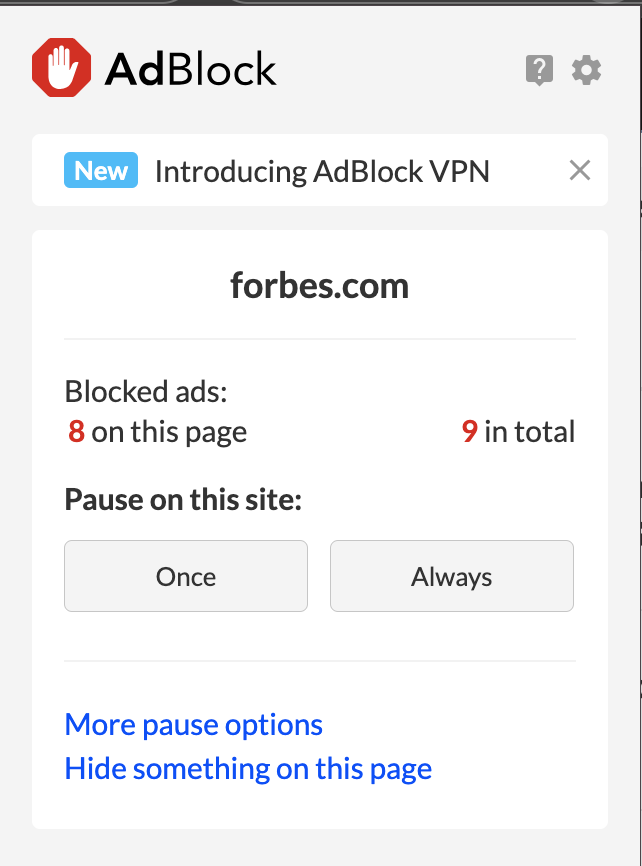
Advertisements have become a thorn in the internet’s flesh. Many websites rely on ads to fund themselves, and ads don’t pay so much except for publishers with big numbers. This factor has led many publishers to focus too much on advertisements over content and inadvertently ruin users’ experience.
Ask an internet user about their everyday problems, and you’ll likely hear about ads. Excessive ads have made many cherished websites challenging to use, angering users. Fortunately, there’s a proven solution to this problem: an ad blocker.
Ad blockers detect and restrict ads from their source, allowing you to surf the web without encountering obnoxious content. AdBlock is one of the best ad blockers available, and it’s free to use. We’re reviewing AdBlock to help you decide whether it’s worth adopting, covering its features, interface, customer support, and other essential aspects.
AdBlock: Plans and Pricing
AdBlock is a free browser extension for Chrome, Firefox, Safari, Edge, and Samsung Internet. It allows you to enjoy ad-free browsing without paying a dime, but there’s a catch. AdBlock is maintained by Eyeo GmbH, a German company that also offers a paid product called AdBlock Plus.
AdBlock Plus offers more advanced features than AdBlock, e.g., a mobile app. One of the main drawbacks we observed when using AdBlock was frequent popups advertising the AdBlock Plus offering. Sure, AdBlock effectively blocks ads, but showing its own ad felt off-putting. However, we could understand that as the small price for enjoying a free ad blocker.

AdBlock: Features
Our test began with downloading the AdBlock extension from the Chrome extension store, and the process was smooth. Downloading and adding the extension took less than a minute, and we began our journey to test every nook and cranny of this app.
AdBlock is a free tool, but after downloading it, we noticed a prompt requesting a possible donation to the development team. This donation is optional, so you don't have to pay any dime, but you're free to chip in a one-off, monthly, or annual contribution if you’re delighted with the app.
Like most ad blockers, AdBlock scans and checks your browser requests against filtering rules. The app has built-in lists of domains known to serve ads and trackers, and it blocks any request to such domains on your browser. Hence, you'll see an empty space in those slots where ads usually appear.
AdBlock gives you details about the advertisements it has detected and blocked. For example, we opened Forbes.com, and AdBlock indicated blocking 8 ads from the browser. You’ll see the stats for every website you visit, helping you verify that AdBlock is doing its job.
Of course, you might not want to block all ads entirely. You may have some trusted sites that you want to permit to show ads. AdBlock lets you customize your configurations, allowing ads to be displayed on specific domains. You can exempt as many domains as you want from ad blocking.
We noticed that AdBlock is one of the few ad blockers we’ve reviewed that allows “Acceptable Ads,” i.e., ads the developers deem non-intrusive. Some publishers participate in the Acceptable Ads program, agreeing to adhere to standards that make their ads non-intrusive. Acceptable Ads are enabled by default, but you can head to the settings page and turn them off if you don’t want to see any ads.
We also observed that the AdBlock extension collects some browsing data, which the developers presumably sell to make money. You can also opt out of this default feature. Despite its effectiveness in blocking ads, we consider the Acceptable Ads program and default data collection drawbacks to using this platform, unlike some free and open-source rivals that have no acceptable ads program or collect any browsing data.
AdBlock is free, but valuable features are hidden behind the AdBlock Plus subscription, such as the cookie consent cutter, custom themes, backup & sync, and image swap (swapping ads with pictures of cats, dogs, and nature). Some ad blockers offer these features for free, but that’s not the case with AdBlock.

AdBlock: Interface and In-Use
AdBlock has a user-friendly interface you’ll likely enjoy using. We didn’t face any noteworthy difficulties downloading and using the extension. It works smoothly, and the settings app is designed to be easy to understand. We liked that we could see detailed stats about the ads blocked over time and switch between different settings without hassles.
The main drawback we observed in this criterion is that AdBlock lacks a mobile app. Only AdBlock Plus subscribers can access a mobile app to block ads while surfing the web on their smartphone.

AdBlock: Customer Support
AdBlock is a free tool, so don’t expect much customer support. There’s no support team to contact as a free user, so you must figure out most issues yourself. However, we appreciate that AdBlock provides a detailed Knowledge Base and FAQ section on its website. The website contains tutorials about AdBlock features and in-depth answers to customers' common questions. You can always consult it for help if you face any issues with the app.
AdBlock: The Competition
AdBlock has competitors you should know about, such as uBlock Origin and Ghostery. These are two effective ad-blockers you can use free of charge, just like AdBlock. They are suitable alternatives but don’t offer much to make them stand out from AdBlock.
AdBlock: Final Verdict
AdBlock is an excellent choice if you’re looking for a free ad blocker to make your browsing experience more enjoyable. It doesn’t offer much outside ad-blocking (except if you’re on the premium AdBlock Plus subscription). However, it does its job very well and significantly improves your browsing experience.
- We've listed the best adblockers







